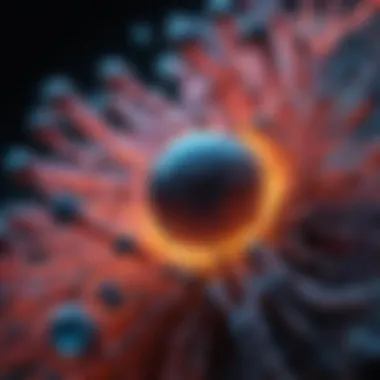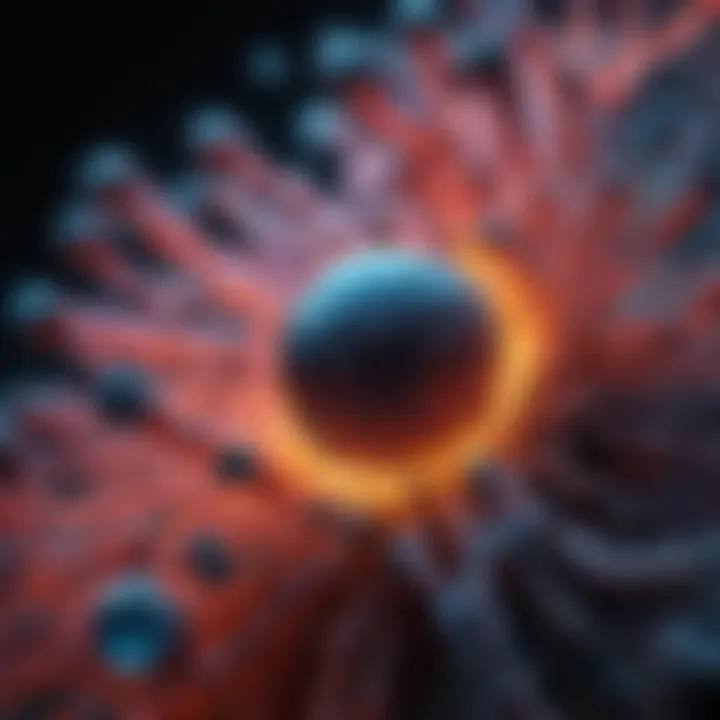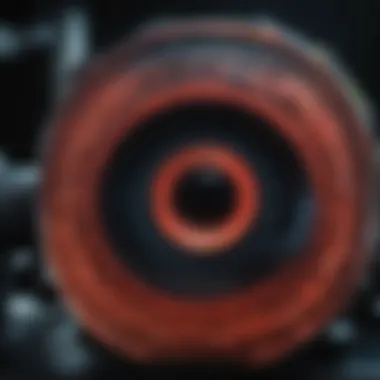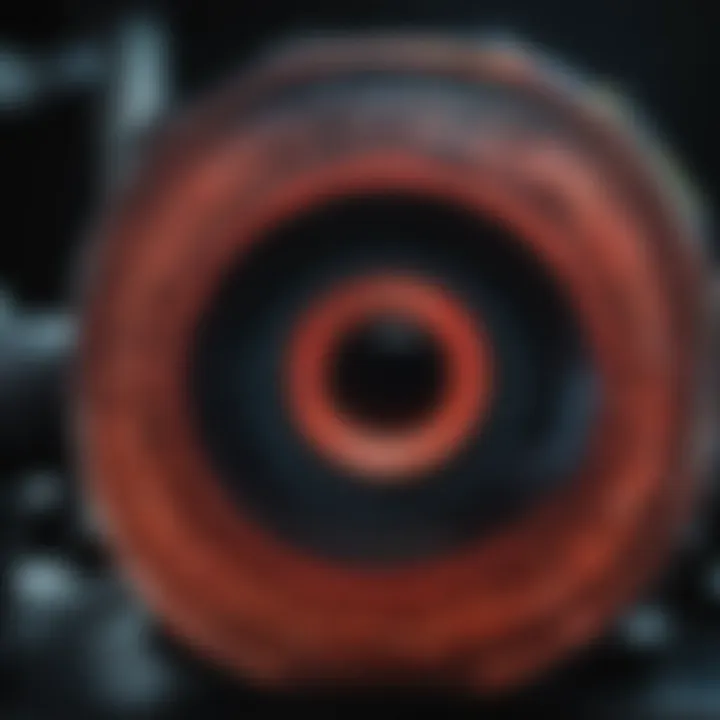Leica Fluorescence Microscopy: Principles and Applications


Intro
Leica fluorescence microscopy has transformed the way scientists observe biological samples. The technology allows for the visualization of cellular structures and processes with impressive clarity and specificity. As researchers strive to uncover the complexities of life at the molecular level, this microscopy type gives them the tools to illuminate the unseen. In this exploration, we will dissect the principles, applications, and future directions of Leica fluorescence microscopy, examining its contributions to various scientific fields.
Research Overview
Summary of Key Findings
Fluorescence microscopy enhances our understanding of biological mechanisms. Key findings from studies using Leica technologies showcase their agility in capturing dynamic processes. For instance, researchers have successfully utilized advanced imaging techniques to track protein localization in live cells, revealing unprecedented insights into intracellular activities.
This innovative approach has led to several notable discoveries:
- Dynamic cellular processes: Time-lapse imaging allows scientists to observe real-time changes within cells, highlighting behaviors previously thought static.
- Subcellular mapping: By employing specific fluorophore tagging, researchers achieve remarkable specificity in identifying organelles and protein interactions.
- Imaging beyond the limits: The super-resolution capabilities enable researchers to bypass traditional optical limits, granting access to details at the nanometer scale.
Importance of the Research in its Respective Field
The advancements in Leica fluorescence microscopy play a critical role in various fields of biological research. For instance, studies in cell biology, neuroscience, and even pharmacology benefit significantly from precise imaging. The ability to visualize molecules and cells in their native context opens doors to understanding disease mechanisms and testing new treatments.
"Fluorescence microscopy has fundamentally changed the landscape of biological research, allowing for a closer look at living specimens without interfering with their natural states."
Methodology
Description of the Experimental or Analytical Methods Used
The methodology employed in fluorescence microscopy varies based on the specific research question. However, Leica systems are typically designed with particular components in mind:
- Light Sources: Laser light sources often maximize the excitation of fluorophores.
- Filters and Optics: Specific filter sets help to select the right wavelengths for excitation and emission, ensuring the relevant signals are captured.
- Imaging Techniques: Methods like confocal or two-photon microscopy are employed to enhance depth and contrast, distinguishing different layers in a sample.
Sampling Criteria and Data Collection Techniques
Sampling criteria typically hinge on the biological system studied and the specific questions addressed. Researchers might collect:
- Live cell samples for dynamic imaging or fixed samples for structural studies.
- Specific cell lines or tissues that express desired markers to facilitate the study of particular pathways or interactions.
The data collection often involves sophisticated software that aids in analysis and interpretation, allowing researchers to manage large datasets generated during imaging sessions.
Preface to Fluorescence Microscopy
Fluorescence microscopy is an essential tool in modern biological research. It allows scientists to visualize and study structures at a cellular or molecular level with a clarity and precision that is often beyond the reach of other imaging methods, making it invaluable in various fields including cell biology, neuroscience, and clinical research.
With fluorescence microscopy, researchers can track the behavior of fluorophores, molecules that emit light when excited by a specific wavelength. This clarity enables a better understanding of biological processes. So, when we dive into the inner workings of Leica fluorescence microscopy, we are not just discussing a tool but a gateway to numerous discoveries that have the potential to reshape our understanding of life itself.
Historical Context
The journey into fluorescence microscopy is rooted in a rich history that spans over a century. Initially, the principles of fluorescence were explored in the late 19th century, paving the way for what would eventually evolve into sophisticated imaging techniques. Key milestones include the invention of the first fluorescing dyes and the development of rudimentary optical instruments that could exploit these properties. As time went on, advancements in technology, particularly in light source innovation and image processing, led to the rise of modern fluorescence microscopy.
For example, the introduction of UV light sources marked a turning point, guiding researchers to more diverse applications. Fast forward to the 21st century, companies like Leica Microsystems have elevated these technologies, making them more accessible and versatile for researchers.
Fundamental Principles
Understanding the fundamental principles of fluorescence microscopy is crucial for anyone looking to appreciate its applications fully. At its core, the technique is inspired by the basic science of fluorescence, where certain substances absorb photons and re-emit them at longer wavelengths. Let’s break down the nuances:
Excitation and Emission
Excitation and emission are the backbone of fluorescence microscopy. In simple terms, when a fluorophore absorbs light energy (excitation), it jumps to a higher energy state. When it returns to its normal state, it releases energy in the form of light (emission). This bright emission is what makes the sample easily visible against a darker background. The key characteristic here is that this distinction allows researchers to differentiate between structures based on their fluorescence properties, enhancing diagnostic capabilities.
What sets excitation and emission apart is how selective it is; this selectivity allows researchers to target specific cellular components. However, a notable limitation could be the need for specific light sources, like lasers, to obtain sufficient excitation.
Stokes Shift
Stokes Shift is another vital principle in fluorescence microscopy. Simply put, it refers to the difference in wavelength between the absorbed light and the emitted light. This phenomenon is critically important because it ensures that unwanted scattered light can be eliminated, allowing for clearer images.
The unique feature of Stokes Shift is that it helps prevent interference from the excitation light, enhancing the specificity of the observation. However, researchers must pay attention to the choice of fluorophores—some may have a minimal Stokes Shift, posing a challenge during imaging.
Fluorophores and Labeling Techniques
Fluorophores serve as the stars of fluorescence microscopy. They are molecules that absorb light at one wavelength and emit it at another, enabling visualization of cellular structures. The specific aspect of fluorophores and labeling techniques focuses on how they can be tailored to bind to specific proteins or genes.
This flexibility makes fluorophores particularly attractive; they can be fine-tuned for a variety of applications—from basic research to complex clinical diagnostics. Nevertheless, they do come with considerations like potential photobleaching, which can limit their usefulness during prolonged observations.
In summary, these fundamental principles not only lay the groundwork for the functionality of fluorescence microscopy but also illuminate the path for continued innovation in the field. Through understanding excitation and emission, Stokes Shift, and the unique characteristics of fluorophores, researchers are better equipped to harness the power of this remarkable imaging technique.
Leica Microsystems: Innovations and Technology


Leica Microsystems has carved a notable niche in the realm of fluorescence microscopy, driving substantial innovations that enhance the capability of researchers. The importance of understanding these innovations lies in their potential to elevate scientific research across various domains. By harnessing the unique technological advancements offered by Leica, researchers can achieve new heights in their analytical and observational abilities.
Overview of Leica Microsystems
Founded in the 19th century, Leica Microsystems has been a trailblazer in microscopy and imaging solutions. Renowned for their commitment to innovation, Leica continues to push the envelope in instrumentation and technology. Their portfolio, ranging from basic research systems to advanced imaging solutions, reflects a consistent aim toward enhancing user experience and accuracy in observations. This evolution in their technology ensures that scientists and researchers all over the world have access to cutting-edge tools, which significantly impact the outcome of their experiments. The resonance of Leica's technologies can be seen in laboratories where precision and clarity are of utmost importance.
Key Technologies in Leica Systems
Delving deeper into the innovations offered by Leica, we find several key technologies that truly set their systems apart. Each of these elements plays an important role in the overall functionality and effectiveness of fluorescence microscopy.
Advanced Light Sources
One of the standout features of Leica systems is the advanced light sources they incorporate. These light sources are not just ordinary lamps; rather, they include options such as high-intensity LEDs that provide exceptional brightness and consistency, which is crucial when studying delicate specimens.
The characteristic that makes these light sources particularly notable is their capability to generate specific wavelengths tailored for excitation of various fluorophores. This feature is a game changer; it allows researchers to choose the optimal light source for their specific experiments, enhancing the quality of imaging considerably.
However, some might argue that the high intensity could lead to photobleaching, which is a trade-off to consider, especially with sensitive biological samples. It’s a balancing act, but when managed well, the benefits far outweigh the drawbacks.
High-Resolution Imaging
High-resolution imaging is another exemplary feature of Leica fluorescence microscopes. The emphasis on resolution in imaging is paramount as it determines the level of detail that can be captured. Leica’s systems employ state-of-the-art optics and sensors which collectively enhance the resolving power, allowing users to visualize structures at the nanometer scale.
The ability to discern minute details means that important biological processes can be observed without ambiguity, facilitating ground-breaking discoveries in cell biology and related fields. However, one should remain aware that achieving such high resolution may require meticulous specimen preparation, an aspect that could deter some users especially if they aren't familiar with advanced techniques.
Modularity and Customization
Lastly, Leica’s emphasis on modularity and customization provides users with a distinctive edge. The ability to tailor microscopes by swapping out components to meet specific experimental needs is a significant advantage. This means that users can upgrade their systems without having to invest in entirely new apparatuses, which makes Leica a popular choice amongst both new and seasoned researchers.
The customizable features allow researchers the flexibility to configure their microscopy systems to suit specific applications, be it metabolic imaging or protein localization studies. However, it’s worth noting that the sheer diversity of options can sometimes be overwhelming for beginners, making it essential for users to have a clear understanding of their experimental objectives before diving into customization.
In summary, Leica Microsystems continues to be a beacon of innovation in the field of fluorescence microscopy. Their advanced technologies not only enhance imaging capabilities but also empower researchers to push the boundaries of their scientific inquiries.
Instrumentation and Setting Up Leica Fluorescence Microscopes
When it comes to making the most out of fluorescence microscopy, the importance of proper instrumentation and setup can't be stressed enough. The key to unlocking the potential of this sophisticated imaging technique lies in the configuration of equipment and the meticulous preparation of samples. Understanding each component and technique helps highlight the nuanced advantages that Leica fluorescence microscopy provides researchers, leading to more accurate results and groundbreaking discoveries.
Microscope Components
Objective Lenses
Objective lenses are perhaps one of the most critical elements in the fluorescence microscope setup. Their primary role is to collect light from the specimen and focus it to produce an image. This component directly influences the resolution and image quality. Leica’s objective lenses often feature high numerical apertures, which allows them to gather more light and resolve finer details in samples.
A standout characteristic of these lenses is their specialized coatings designed to enhance transmission of specific wavelengths of light, which are essential when dealing with fluorescent signals. This quality makes them especially popular among researchers who need precision and clarity in their imaging work.
However, one should also be cautious; while high-performance lenses are a benefit, they are also more expensive. Choosing the right objective lens involves balancing cost against the need for excellent imaging performance in fluorescence microscopy.
Filters and Dichroic Mirrors
Moving on to filters and dichroic mirrors, these components are equally vital for effective fluorescence microscopy. Filters are used to selectively transmit specific wavelengths of light that excite the fluorophores, allowing for very targeted imaging. Dichroic mirrors, on the other hand, play a crucial role by directing the emitted fluorescent light toward the detector while blocking the excitation light.
A notable feature of these optical elements is their ability to minimize background noise, enhancing the signal-to-noise ratio. This is often a deciding factor for researchers who require high sensitivity in their experiments. However, improper alignment or dirty filters can lead to significant imaging issues. Making sure these components are well maintained is essential for achieving optimal results.
Cameras and Capture Devices
Finally, we turn our attention to cameras and capture devices, which serve as the eyes of the fluorescence microscope. These devices translate the light signals that have been captured by the optics into digital images that researchers can analyze. High-quality cameras enhance the overall imaging capability, enabling researchers to capture fine details in their samples. The unique feature of modern Leica cameras is their ability to operate at high speeds, which is particularly useful for observing dynamic processes in living cells. This capability allows for real-time imaging, which can be a game-changer in various research fields. Yet, researchers ought to consider the trade-off between high sensitivity and speed, as sometimes lowering one may enhance the other.
Sample Preparation Techniques
The discussion of Leica fluorescence microscopy would be incomplete without addressing sample preparation techniques, which lay the groundwork for successful imaging. Properly prepared specimens ensure that the data generated from imaging are valid and reliable, which is crucial for any scientific inquiry.
Specimen Mounting
Specimen mounting involves the careful placement of samples onto a microscope slide and includes using appropriate mounting media to preserve fluorophores and prevent environmental damage. An important characteristic of proper mounting is that it can enhance the clarity of the images collected during microscopy. Researchers often opt for specialized media that have refractive indices matching that of the glass slide to minimize light refraction.
However, the pitfalls of mounting can sometimes be overlooked; poorly prepared specimens may lead to artifacts in imaging. The balance of time spent in preparation often pays dividends in the quality of results.
Fluorescent Dyes
Another crucial aspect of sample preparation involves the use of fluorescent dyes. These substances bind to specific cellular components, allowing researchers to visualize structures or processes that would otherwise be invisible. A key benefit of fluorescent dyes is their variety—there’s a plethora of options available that allow targeting different biological pathways.
However, dyes must be chosen judiciously, as some can display toxicity and alter the behavior of live cells, potentially skewing results. Hence, careful selection of dyes is imperative to work effectively with living specimens in fluorescence imaging.
Controls for Sample Integrity
Lastly, controls for sample integrity should never be ignored. These controls ensure that the changes observed in the samples are due to specific alterations rather than artifacts caused by preparation or imaging techniques. One common method is including negative controls that lack the fluorescent labels, allowing researchers to gauge baseline noise. Maintaining high standards in control samples helps to eliminate potential sources of error and fosters trust in results.
"In the world of fluorescence microscopy, preparation is half the battle won. Without careful instrument setup and specimen handling, the brilliance of the imaging can be lost in the noise."
Imaging Techniques in Leica Fluorescence Microscopy
Understanding the imaging techniques in Leica fluorescence microscopy is crucial for grasping how researchers explore the depths of biological systems. The evolving methodologies allow for precision in imaging, enhancing both the quality and reliability of data gathered. Each technique—ranging from widefield approaches to cutting-edge fluorescence lifetime imaging—not only serves a distinct purpose but also brings unique advantages and considerations to the table.
By leveraging these imaging techniques, researchers can extract intricate details from cellular components, paving the way for groundbreaking discoveries across various fields.


Widefield Fluorescence Microscopy
Widefield fluorescence microscopy is known for its straightforward setup and ease of use. This method relies on the illumination of the entire sample, which creates a bright field of view. One of the prominent features of this technique is its ability to capture images rapidly, making it suitable for observing dynamic biological processes. In practice, this translates to a swift collection of data, crucial for experiments requiring real-time information.
However, while widefield microscopy permits fast imaging, it also introduces a challenge: background noise can saturate the data. Thus, securing high-quality images often requires meticulous sample preparation and expert use of filters to minimize interference.
Confocal Microscopy
Confocal microscopy represents a leap forward from traditional widefield methods. By employing focused laser light, this technique achieves exceptional spatial resolution and contrast. It eliminates out-of-focus light, enabling clearer images of thick specimens.
Advantages over Widefield
The hallmark advantage of confocal microscopy lies in its ability to generate high-resolution, layered images of samples. By reconstructing these layers, researchers can create three-dimensional visuals of cellular structures, offering insight into their spatial organization. This exceptional resolution makes confocal microscopy a favored choice among scientists delving into cellular anatomy and dynamics. Its precision shines especially in studies of intricate tissues, where understanding spatial relationships can lead to significant biological insights.
Applications in Cellular Biology
When it comes to cellular biology, confocal microscopy serves as a pivotal method for analyzing spatial distribution among cellular components. By employing fluorescent markers, it enables the visualization of interactions between proteins within cells, thus facilitating our understanding of signal transduction pathways. The technique is widely embraced for its ability to provide essential data that robustly informs biological research.
The uniqueness of confocal microscopy lies in its fine resolution and ability to delve into three-dimensional structures, allowing for nuanced explorations of cell behavior and function over time. As such, it plays an integral role in advancing our comprehension of biological processes at a cellular level.
Fluorescence Lifetime Imaging Microscopy (FLIM)
Fluorescence Lifetime Imaging Microscopy (FLIM) is a relatively innovative approach that goes beyond what is traditionally possible with standard imaging techniques. By measuring the decay time of fluorescence emissions, FLIM offers deeper insight into molecular environments. Understanding these lifetimes is critical, as it can provide information about the molecular interactions and local environments beyond what intensity-based measurements can achieve.
Principles of FLIM
The principles of FLIM are based on observing how long molecules emit light after they've been excited. Different environments impact these lifetimes, and thus, FLIM allows researchers to discern variations in molecular dynamics and interactions with remarkable specificity. It is especially beneficial when studying molecular complexes, as the technique can highlight subtle shifts in interactions that may occur under various experimental conditions.
Quantitative Analysis Applications
When it comes to quantitative analysis, FLIM hits the nail on the head. By providing a means to quantitatively evaluate molecular interactions, it has become a crucial technique in varied scientific inquiries. Researchers can glean information regarding molecular ratios, binding affinities, and the dynamics of complex formations. This offers a more profound understanding of not only how molecules behave individually but also how they calculate interactions as part of larger biological processes. The technique serves as a powerful tool for elucidating cellular mechanisms and potential therapeutic targets in disease contexts.
"Incorporating FLIM into research practices allows for a multi-dimensional analysis of cellular processes that was previously unattainable."
In summary, the imaging techniques associated with Leica fluorescence microscopy are integral to unraveling the complexities of biological systems. From the accessible widefield approach to the precision of confocal methods and the nuanced insights garnered through FLIM, these methodologies empower researchers to explore, discover, and ultimately, gain deeper insights into the living world.
Applications Across Scientific Disciplines
Leica fluorescence microscopy is instrumental in bridging various scientific domains, providing critical insights that drive research and innovation. The versatility of this technology allows it to play a significant role in cell biology, neuroscience, botany, and clinical research. By enhancing our understanding at the cellular and molecular levels, it helps researchers tackle intricate questions and challenges across these fields.
Cell Biology and Developmental Studies
In cell biology, Leica fluorescence microscopy enables scientists to visualize cellular structures and processes during development. For instance, tracking the movement of protein and the organization of cellular organelles can give insight into how cells respond to their environment. This capability is vital for studies involving stem cells, where researchers can study differentiation and development stages. Using specific fluorophores targeting different components, researchers can label various structures, giving a multi-dimensional view of cellular dynamics.
"The ability to see how cells interact and function in real-time provides unprecedented opportunities to dissect biological processes."
Additionally, fluorescence microscopy aids in identifying cellular abnormalities that can lead to diseases. Thus, its application not only enhances our basic understanding but also contributes to translating discoveries into therapeutic strategies.
Neuroscience and Imaging Neural Structures
Neuroscience heavily relies on fluorescence microscopy to explore the complexities of neural structures and functions. The intricacies of synaptic transmission can be dissected using fluorescent markers that specifically label neurons or synapse-related proteins. For example, researchers can observe how neurotransmitters interact at synaptic junctions, revealing the dynamics of neural communication. This microscopic approach can be revolutionizing when assessing neurodegenerative diseases, allowing scientists to visualize the degeneration of neuronal pathways and the formation of amyloid plaques.
The precision of Leica systems also allows for high-resolution imaging of brain slices, providing clarity in the study of brain circuitry. These capabilities make it a go-to choice for those investigating neuralPlasticity and disease mechanisms.
Plant Sciences and Fluorescence in Botany
In the field of plant sciences, fluorescence microscopy is an invaluable tool for studying plant cells and tissues. It allows for the examination of chloroplasts, which are key to understanding photosynthesis at a cellular level. Through tagging specific proteins involved in metabolic pathways, scientists can trace their roles in plant development. Fluorescence microscopy can also highlight the response of plants to environmental changes, giving insights into mechanisms of adaptation and survival in changing climates.
Moreover, using fluorescence, researchers can detect plant diseases at an early stage by analyzing pathogen invasion and response. Thus, this technology not only pushes forward basic research but also supports agricultural advancements by informing breeding and crop management practices.
Applications in Clinical Research
Diagnostics and Biomarkers
In clinical research, Leica fluorescence microscopy plays a crucial role in diagnosing diseases through the identification of biomarkers. Specific proteins, often involved in disease pathways, can be tagged with fluorescent dyes. This characteristic makes it easier to recognize disease states at an early stage. By applying this method, oncologists can evaluate tumor markers that indicate malignancy, tailoring treatment strategies more effectively.
The key feature of diagnostic assays utilizing fluorescence is their ability to yield fast and accurate results. This is significant, as early diagnostics are vital for improving patient outcomes. However, the challenge lies in the specificity of the dyes used; if they exhibit cross-reactivity with similar proteins, it can lead to diagnostic errors.
Drug Development Insights
Another critical aspect is drug development, where fluorescence microscopy helps researchers monitor the cellular uptake of drug compounds. By labeling drugs with fluorescent tags, scientists can visualize how effectively these compounds are entering cells and their subsequent distribution within cellular compartments. This also aids in assessing the effectiveness of drug candidates in targeting specific pathways linked to diseases.
The distinct advantage of using fluorescence microscopy in this context is its ability to provide real-time insights into the kinetics of drug action, offering a clearer picture than traditional methods. However, the dependency on fluorescent labels can be a double-edged sword; choosing the wrong label may result in misleading conclusions about drug efficacy.


By exploring these applications, this article lays out the multifaceted contributions of Leica fluorescence microscopy across various scientific disciplines, emphasizing its importance in advancing our understanding of life's complexities.
Advantages of Leica Fluorescence Microscopy
Leica fluorescence microscopy represents a substantial leap in the field of imaging technology. Its advantages position it as a go-to choice for researchers across various scientific disciplines. This section elucidates key aspects that accentuate the significance of using Leica systems, notably focusing on high sensitivity, specificity, and real-time imaging capabilities.
High Sensitivity and Specificity
One of the standout features of Leica fluorescence microscopes is their high sensitivity and specificity. High sensitivity allows detection of minute quantities of fluorophores for cellular structures or processes, enhancing the overall quality of research findings. Interesting enough, this heightened sensitivity stems largely from the advanced light sources employed in Leica systems. These sources can achieve a precise and intense output of light that is essential for effectively exciting fluorescent molecules.
Sensitivity is not merely about capturing signals; it’s also about reducing background noise. The engineered optics and precise filtering mechanisms in Leica systems help in eliminating unwanted signals. This combination leads to clearer images and more accurate interpretations of complex biological phenomena.
Furthermore, specificity nurtures the ability to target distinct biomarkers in a sample. By utilizing fluorescent labeling techniques, researchers can stain certain structures, illuminating them distinctly against the background. This precise identification is crucial in areas such as cell biology, where differentiating between various cell types can be pivotal in understanding developmental processes or disease mechanisms. Researchers can hone in on specific cell compartments or molecular interactions, which could otherwise go unnoticed.
Real-Time Imaging Capabilities
Another impressive feature of Leica fluorescence microscopy is its ability to capture real-time imaging. While traditional methods often involve static images that might miss dynamic events, Leica facilitates the observation of live samples over extended periods. This capability is a game changer, especially in studies of cellular behaviors or real-time interactions between molecules.
Monitoring processes as they unfold can provide a wealth of information. For instance, in live-cell imaging, researchers can track migration patterns, proliferation rates, and even apoptotic events in real-time. This dynamic perspective allows for much richer data collection compared to static image analysis, and it significantly elevates the understanding of biological processes.
Moreover, the relatively low phototoxicity inherent in Leica systems enables longer experimentation periods without harming living specimens. Consequently, researchers can explore a broad spectrum of phenomena that require continuous observation—something not feasible with other less sophisticated systems.
"The ability to visualize biological processes in real-time is not just advantageous; it's essential for comprehending the complexities of life at the microscopic level."
In summary, the advantages of using Leica fluorescence microscopy are manifold, ranging from high sensitivity and specificity to robust real-time imaging capabilities. These elements contribute significantly towards deeper insights into biological research, making it an invaluable tool in modern scientific inquiry.
Limitations and Considerations
Understanding the limitations and considerations surrounding Leica fluorescence microscopy is crucial for a balanced perspective on its application. While it heralds remarkable imaging prowess, several challenges must be acknowledged to optimize usages and mitigate adverse outcomes. Recognizing these aspects not only aids researchers in selecting appropriate methodologies but also fosters improvements in imaging technology. Factors like light sensitivity, sample integrity, and imaging conditions play pivotal roles. A nuanced comprehension of these limitations can thus pave the way for innovative solutions in microscopy.
Photobleaching Effects
Photobleaching is one of the most notorious pitfalls in fluorescence microscopy. This phenomenon occurs when a fluorophore loses its ability to emit fluorescence upon illumination, rendering the sample ineffective for imaging. Each fluorophore has a specific lifespan, and constant exposure to light can lead to a rapid decline in signal. The importance of this issue becomes evident when considering experiments requiring prolonged observation times.
To mitigate photobleaching,
- Optimize illumination intensity: Reducing the brightness of the light source can prolong fluorophore viability.
- Utilize fluorophores with higher quantum yields: Such substances resist photobleaching longer and maintain brightness over extended periods.
- Consider time-lapse imaging: Acquiring images at intervals can minimize exposure time, preserving sample integrity while still acquiring necessary data.
As an example, in studies exploring the dynamics of cellular processes, skipping unnecessary frames can lead to significant gains in sample longevity while generating data that detail cellular interactions precisely.
Auto-fluorescence Challenges
Another hiccup researchers often face is auto-fluorescence. This arises when biological samples naturally emit light due to their intrinsic properties, particularly under certain illumination conditions. This unwanted background signal can obscure or drown out the fluorescence signal from tagged molecules, complicating data analysis.
Auto-fluorescence is particularly prevalent in:
- Plant tissues, where chlorophyll often exhibits strong auto-fluorescent properties.
- Tissues rich in certain cellular structures, like lipofuscin.
To tackle auto-florescence, scientists can implement various strategies:
- Select appropriate wavelengths for excitation: Targeting wavelengths that avoid the peak auto-fluorescence emission can help isolate desired signals.
- Utilize spectral unmixing techniques: This allows differentiation between auto-fluorescent signals and those from fluorophores.
For instance, using spectral imaging systems helps discern fine details among complex biological samples, enabling more precise results even in challenging backgrounds.
"In fluorescence microscopy, foresight in planning for limitations can be as crucial as the experimental design itself."
Looking Ahead: Future Directions in Fluorescence Microscopy
The field of fluorescence microscopy is not just a static realm of scientific observation; it is alive with innovation and evolving technologies. Looking ahead at future directions in fluorescence microscopy, especially through the lens of Leica’s groundbreaking contributions, highlights not only emerging capabilities but also methodologies that promise to redefine our understanding of biological phenomena.
Emerging Technologies
Emerging technologies present significant opportunities to expand the frontiers of fluorescence microscopy. Notable advancements include:
- Super-resolution Techniques: Methods like STED and PALM allow imaging beyond the diffraction limit, enabling researchers to explore molecular interactions with unparalleled detail. This development will markedly enhance the resolution at which cellular processes can be visualized.
- Multi-Photon Microscopy: Leveraging longer wavelengths for excitation minimizes photodamage and allows imaging deeper into tissue samples. This technique is particularly promising for live cell imaging in a physiological context.
- DNA-Encoded Fluorophores: As these novel imaging agents proliferate, their ability to target specific molecular pathways may revolutionize the precision of fluorescence microscopy techniques. This could lead to more accurate spatial and quantitative measurements within cells.
- AI and Machine Learning: Incorporating artificial intelligence into image analysis offers the potential to sift through vast datasets, streamline image processing, and enhance feature extraction. The power of AI may aid researchers in uncovering intricate patterns and relationships in biological systems that were previously beyond human capabilities.
These emerging technologies not only bolster the current capabilities of Leica fluorescence microscopy but also set the stage for future research that will likely refocus the narrative in many scientific domains.
Integration with Other Imaging Modalities
Integrating fluorescence microscopy with other imaging techniques opens up a world of possibilities, enabling a more holistic understanding of biological systems. Here are several key integrations to consider:
- Fluorescence and Electron Microscopy: Combining fluorescence microscopy with electron microscopy allows for high-resolution structural details to be paired with functional information, bridging the gap between molecular expression and ultrastructure. This hybrid approach could yield significant insights, particularly in fields like cell biology and materials science.
- Fluorescence and MRI: The coupling of fluorescence mapping with magnetic resonance imaging could help correlate molecular information with macroscopic tissue architecture, particularly useful in clinical environments for tumor imaging and diagnosis.
- Fluorescence and Atomic Force Microscopy: Merging these techniques enables simultaneous topographical and fluorescence measurements. This will offer new avenues to study cellular adhesion processes, protein interactions, and membrane dynamics at the nanoscale.
The fusion of different imaging modalities offers a more comprehensive toolkit for researchers, providing richer datasets for understanding complex biological questions.
"The future of fluorescence microscopy lies in its integration with other advanced imaging techniques, which will redefine how we view and analyze biological systems."
As we venture into the future, Leica’s commitment to enhancing fluorescence microscopy through innovative technologies and interdisciplinary strategies is poised to drive remarkable discoveries in the life sciences, ultimately enriching our knowledge of the intricate dance of life at the molecular level.







